 At the 2013 Consumer Electronics Show Meridian very quietly and behind closed doors introduced a new pocket-sized USB DAC / headphone amplifier named the Meridian Explorer. I was very excited by the external and internal look of the Explorer. The extruded brushed aluminum enclosure and the six layer circuit board containing giant Nichicon caps, an XMOS L1 processor, and audiophile grade components throughout were extremely impressive. The specs were also superb. Notably the asynchronous USB input, support for all popular PCM sample rates up through 192 kHz, fixed and variable analog output, optical output, and digitally controlled analog volume attenuation. I declined the offer to listen through the Explorer in the Meridian suite because the conditions were less than good. The ambient noise, unfamiliar headphones, unfamiliar music, and limited time wouldn’t have helped me develop an accurate first impression. Thus I flew back to Minneapolis and awaited the Explorer’s arrival. My first impression of this $299 DAC’s sound quality in my system was excellent. Throughout the review period I compared the Explorer to a $249 competitor by listening through my Ultimate Ears 11 Pro, Etymotic ER4-P, and Sennheiser HD600 headphones. As each listening session passed I liked the sound of the Explorer even more. The Meridian Explorer has entered this market segment on top and is definitely the portable USB DAC to beat.[PRBREAK][/PRBREAK]
At the 2013 Consumer Electronics Show Meridian very quietly and behind closed doors introduced a new pocket-sized USB DAC / headphone amplifier named the Meridian Explorer. I was very excited by the external and internal look of the Explorer. The extruded brushed aluminum enclosure and the six layer circuit board containing giant Nichicon caps, an XMOS L1 processor, and audiophile grade components throughout were extremely impressive. The specs were also superb. Notably the asynchronous USB input, support for all popular PCM sample rates up through 192 kHz, fixed and variable analog output, optical output, and digitally controlled analog volume attenuation. I declined the offer to listen through the Explorer in the Meridian suite because the conditions were less than good. The ambient noise, unfamiliar headphones, unfamiliar music, and limited time wouldn’t have helped me develop an accurate first impression. Thus I flew back to Minneapolis and awaited the Explorer’s arrival. My first impression of this $299 DAC’s sound quality in my system was excellent. Throughout the review period I compared the Explorer to a $249 competitor by listening through my Ultimate Ears 11 Pro, Etymotic ER4-P, and Sennheiser HD600 headphones. As each listening session passed I liked the sound of the Explorer even more. The Meridian Explorer has entered this market segment on top and is definitely the portable USB DAC to beat.[PRBREAK][/PRBREAK]
![]()
![]()
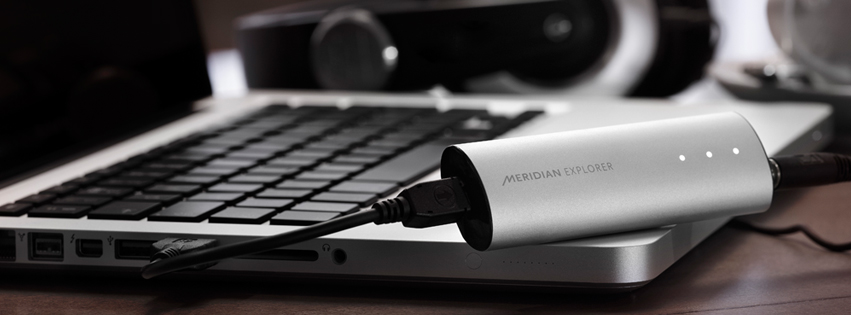
![]()
Meridian Explorer
The Meridian Explorer is a USB digital to analog converter, headphone amp, preamp, and digital to digital converter. On the outside the, 1.76 ounce 4.0 x 1.25 x 0.7 inch, Explorer looks and feels much like the AppleTV silver remote. The Explorer features three LEDs on the top. The LEDs indicate the currently playing track’s speed as 1x, 2x, or 4x. One LED illuminated indicates 1x sample rates of 44.1 or 48 kHz. Two LEDs illuminated indicates 2x sample rates of 88.2 or 96 kHz are being played. When all three LEDs light up the Explorer is playing 4x material at 176.4 or 192 kHz. The bottom of the Explorer has two important items. First it identifies England as the location of the Explorer’s design and manufacturer. That’s a big deal, especially for a $299 product of this caliber. Second, the tiny feet or platform combined with the rubberized label provide an ever so small amount of friction. This friction is really nice in that a right side up Explorer doesn’t slide around as easy as the device would if it were a complete oval with brushed aluminum all around.
 Each end of the Explorer is covered by moulded plastic end caps. One end features a USB mini type B input. This input is powered by a computer’s USB port at a nominal 5V at <500mA and is Class 2 USB audio compliant. Meridian elected to require a USB cable connection rather than build a protruding USB A type connector into the product. I see a few pros with this approach such as less stress on the computer’s USB port, ability to use different USB cables, and I don’t have to worry about blocking an adjacent port on my laptop because of the DAC’s size. During the review I used the included 6.5 inch USB cable and a two meter type A to mini B Wire World Silver Starlight cable. The Explorer’s USB implementation uses the class leading XMOS L1 processor. The XMOS platform is my favorite because it simply works. The Explorer operates asynchronously with low jitter crystal oscillators providing the master clock source. Asynchronous implementations are becoming standard but no less critical. The other implementation called Adaptive USB can be inferior due to its lack of master clocking and lack of flow control for the incoming data stream. The asynchronous USB implementation in the Explorer is designed to handle both clocking and flow control.
Each end of the Explorer is covered by moulded plastic end caps. One end features a USB mini type B input. This input is powered by a computer’s USB port at a nominal 5V at <500mA and is Class 2 USB audio compliant. Meridian elected to require a USB cable connection rather than build a protruding USB A type connector into the product. I see a few pros with this approach such as less stress on the computer’s USB port, ability to use different USB cables, and I don’t have to worry about blocking an adjacent port on my laptop because of the DAC’s size. During the review I used the included 6.5 inch USB cable and a two meter type A to mini B Wire World Silver Starlight cable. The Explorer’s USB implementation uses the class leading XMOS L1 processor. The XMOS platform is my favorite because it simply works. The Explorer operates asynchronously with low jitter crystal oscillators providing the master clock source. Asynchronous implementations are becoming standard but no less critical. The other implementation called Adaptive USB can be inferior due to its lack of master clocking and lack of flow control for the incoming data stream. The asynchronous USB implementation in the Explorer is designed to handle both clocking and flow control.
 The opposite end of the Explorer features three outputs via two ports. One port is solely for headphones with a 3.5mm jack and discrete variable analogue headphone output (130mW into 16Ω). This variable output is a 64 step digitally controlled analog volume control similar to the AudioQuest DragonFly. The computer’s master volume control is what attenuates the analog signal from the Explorer. This is very nice on a Mac laptop where the volume Up/Down/Mute keys or menu bar slider can be used to control the analog volume of the DAC. The second 3.5mm port on this end of the Explorer is a combination 2v RMS analog line out and an optical digital S/PDIF output requiring a mini TosLink to TosLInk cable. Both the analog and digital outputs are programmed without volume control from the factory. Also from the factory, the optical port is limited to a top sample rate output of 96 kHz. Quad speed material at 176.4 and 192 kHz is down sampled before being output via mini TosLink. Readers should note downsampling does not occur with 4x material on the analog outputs.
The opposite end of the Explorer features three outputs via two ports. One port is solely for headphones with a 3.5mm jack and discrete variable analogue headphone output (130mW into 16Ω). This variable output is a 64 step digitally controlled analog volume control similar to the AudioQuest DragonFly. The computer’s master volume control is what attenuates the analog signal from the Explorer. This is very nice on a Mac laptop where the volume Up/Down/Mute keys or menu bar slider can be used to control the analog volume of the DAC. The second 3.5mm port on this end of the Explorer is a combination 2v RMS analog line out and an optical digital S/PDIF output requiring a mini TosLink to TosLInk cable. Both the analog and digital outputs are programmed without volume control from the factory. Also from the factory, the optical port is limited to a top sample rate output of 96 kHz. Quad speed material at 176.4 and 192 kHz is down sampled before being output via mini TosLink. Readers should note downsampling does not occur with 4x material on the analog outputs.
 Astute Computer Audiophiles likely noticed I used the phrase, “from the factory” in the previous paragraph when describing how the Explorer is programmed. I used those words to hint that the Explorer’s configuration is not set in stone. One of the best features of the Meridian Explorer is the ability to customize the product to one’s own needs through simple firmware updates. Most people will accept the factory default configuration and be on their way to sonic bliss. Others can simply run the forthcoming Meridian application to change the device’s firmware in less than ten seconds. At the time of this review the Meridian application was still a work in progress. However, I received instructions from the Meridian mothership in the UK on how to use the Terminal app in OS X to change firmware. The ability to switch backward and forward between predefined features sets is brilliant. During the review I changed the feature set of my Explorer to output 4x sample rates of 176.4 and 192 kHz via its optical digital output. I tested the output for bit transparency through the Berkeley Audio Design Alpha DAC and it passed without issue. As a test I switched between a couple different firmware builds, testing playback after each switch, without a single issue. After the Explorer is publicly launched Meridian plans to release a set of feature firmware images together with its simple OS X and Windows apps that enable users to choose between images at the push of a button. In addition to the 4x sample rate support via optical output Meridian will release firmware images that increase the flexibility of the Explorer well beyond any other product in its class. CA readers familiar with firmware updates of yesteryear know all to well how easy it is too brick a piece of hardware. According to Meridian the Explorer is brick-proof because an unsuccessful upgrade will cause the unit to failover to the default factory image stored in protected memory space. Meridian even went as far as suggesting the firmware update process can be interrupted by pulling the USB cable or resetting one’s computer without causing any harm to the Explorer.
Astute Computer Audiophiles likely noticed I used the phrase, “from the factory” in the previous paragraph when describing how the Explorer is programmed. I used those words to hint that the Explorer’s configuration is not set in stone. One of the best features of the Meridian Explorer is the ability to customize the product to one’s own needs through simple firmware updates. Most people will accept the factory default configuration and be on their way to sonic bliss. Others can simply run the forthcoming Meridian application to change the device’s firmware in less than ten seconds. At the time of this review the Meridian application was still a work in progress. However, I received instructions from the Meridian mothership in the UK on how to use the Terminal app in OS X to change firmware. The ability to switch backward and forward between predefined features sets is brilliant. During the review I changed the feature set of my Explorer to output 4x sample rates of 176.4 and 192 kHz via its optical digital output. I tested the output for bit transparency through the Berkeley Audio Design Alpha DAC and it passed without issue. As a test I switched between a couple different firmware builds, testing playback after each switch, without a single issue. After the Explorer is publicly launched Meridian plans to release a set of feature firmware images together with its simple OS X and Windows apps that enable users to choose between images at the push of a button. In addition to the 4x sample rate support via optical output Meridian will release firmware images that increase the flexibility of the Explorer well beyond any other product in its class. CA readers familiar with firmware updates of yesteryear know all to well how easy it is too brick a piece of hardware. According to Meridian the Explorer is brick-proof because an unsuccessful upgrade will cause the unit to failover to the default factory image stored in protected memory space. Meridian even went as far as suggesting the firmware update process can be interrupted by pulling the USB cable or resetting one’s computer without causing any harm to the Explorer.
Internally the Meridian Explorer is something to behold. A pocket-sized DAC with six layer circuit board full of audiophile grade components and direct coupled outputs for $299 is something this wonderful hobby of ours has never seen. The detailed image below displays all the goodies such as Nichicon caps, linear regulators, XMOS processor, discrete audio clocks, and the PCM5102 24/384 kHz DAC.
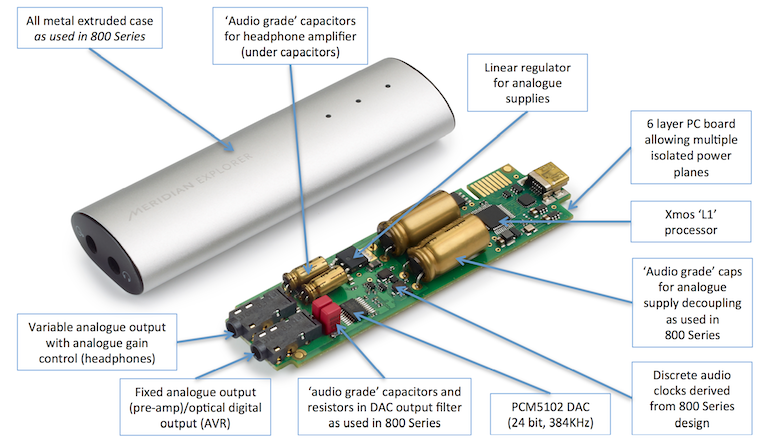
Using the Meridian Explorer
I used the Meridian Explorer in two main capacities, as a headphone amplifier and as a DAC. I tested the Explorer’s ability to convert digital USB input to digital TosLink optical output but only to make sure the unit worked as described. Before the firmware upgrade the digital output of 4x material was down sampled to 2x and after the upgrade all material from 1x through 4x was output bit transparently via TosLink optical.
As a DAC / headphone amp the Explorer was terrific. I used it with my 15” MacBook Pro retina, OS X 10.8.2, Ultimate Ears 11 Pro, Etymotic ER-4P, and Sennheiser HD600 headphones. I tested the Explorer with iTunes, iTunes + Amarra, and Audirvana Plus. In this configuration all three pairs of headphones sounded excellent. The ER-4P and Explorer make a great combination. I ran through my usual playlist of music I know well and didn’t experience any fatigue related to the sound. The Explorer appeared to have endless power and the ability to drive the Etymotics through the sound barrier. My go-to album for acoustic guitar and sonic decay is Ottmar Liebert’s One guitar at 24 bit / 96 kHz. The Explorer / ER-4P combo reproduced this album very well with tight plucks of the strings and good decay. The decay could have been better, but I’ve yet to hear better from device anywhere near this price. Randi Tytingvåg's Red or Dead track as well as Ray LaMontagne’s God Willing The Creek Don’t Rise album sounded really smooth and silky with that last bit of detail somewhat glossed over. My favorite Nat King Cole album The Very Thought of You was a pleasure to listen to over and over. Nat’s vocals were to die for and the signature sound of Capitol Studios came through in all its glory. I could have sat at my local tea shop all day and listening to the entire Analogue Productions remasters of Nat King Cole’s catalog through the ER-4P and Meridian Explorer. Switching off to the Sennheiser HD600s revealed a different but equally as impressive side of the Explorer. The silky smoothness was reduced just a tad in favor of a skosh more detail. I sense there may be more detail in the Explorer just waiting to be released under the right conditions. Toward the end of my listening sessions with the HD600 headphones I was in the mood for one of the best Rap albums of all time, N.W.A.’s Straight Outta Compton ![]() . This album is no audiophile standard but it contains music that I love from some of the most influential artists ever from the Rap genre. The opening three tracks Straight Outta Compton, F**k the Police, and Gangsta Gangsta comprise a hat trick of Gangsta Rap. The HD600 headphones were tightly controlled by the Explorer even under the most punishing bass conditions. I had the volume at 100% for some of the listening and was at my loudness limit. The Explorer couldn’t play any louder but my ears couldn’t handle anything louder. The DragonFly appears to play louder with the HD600 but the sound quality is gone at this volume level. Through the Explorer the bass was very prevalent but well controlled. Contrast that to the DragonFly’s bass that was louder but much muddier and looser. The DragonFly lacks the control of the Explorer not only at high volumes but in most listening scenarios.
. This album is no audiophile standard but it contains music that I love from some of the most influential artists ever from the Rap genre. The opening three tracks Straight Outta Compton, F**k the Police, and Gangsta Gangsta comprise a hat trick of Gangsta Rap. The HD600 headphones were tightly controlled by the Explorer even under the most punishing bass conditions. I had the volume at 100% for some of the listening and was at my loudness limit. The Explorer couldn’t play any louder but my ears couldn’t handle anything louder. The DragonFly appears to play louder with the HD600 but the sound quality is gone at this volume level. Through the Explorer the bass was very prevalent but well controlled. Contrast that to the DragonFly’s bass that was louder but much muddier and looser. The DragonFly lacks the control of the Explorer not only at high volumes but in most listening scenarios.
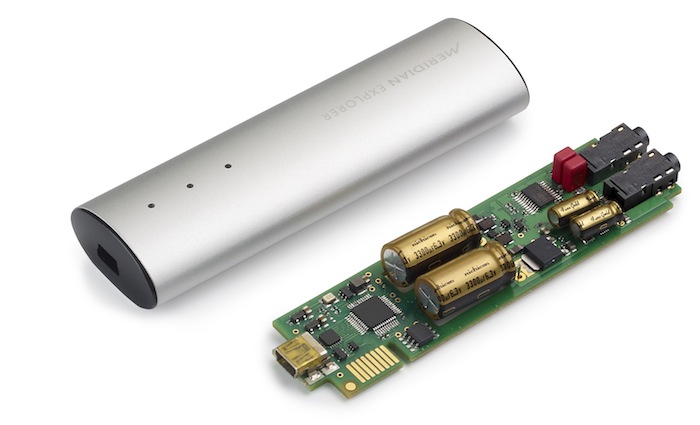
Listening through the Meridian Explorer as a DAC only connected to my main system via its analog line out produced a very similar experience to headphone listening. The sound was very different as one would expect when switching from headphones to a full two channel stereo system but the qualities of the Explorer remained the same. The last bit of detail wasn’t quite there although the smoothness and liquidity were appropriately present. This was never more apparent then listening to Randi Tytingvåg’s Red or Dead. Her vocal wasn’t as piercing as I’ve heard through my system in other configurations. Ben Harper’s By My Side and Glen Hansard’s Rhythm and Repose, both at 24/96, sounded very good. Again I didn’t hear the ultimate in texture or detail but I was listening to the music. That’s what really counts. The Explorer had my attention the entire time.
Comparing the $250 AudioQuest DragonFly to the $299 Meridian Explorer reveals real differences readers can use to make purchasing decision. Nearly twice as long and twice as wide the Explorer is much larger than the DragonFly. Both products are still pocket-sized but if size is most important (large or small) the decision should be easy. The Explorer features optical digital output, reprogrammable feature sets, and support for 176.4 and 192 kHz. The DragonFly offers none of the aforementioned features. The Explorer has a detachable USB cable while the DragonFly has a captive USB type A connector. The Explorer requires drivers on Windows because it supports 4x sample rates. The DragonFly is plug and play. The sonic differences between the two devices are not factual like the specifications. In my listening sessions the Explorer has a larger sound stage, more control, and an overall better sound. The DragonFly is the 2012 Computer Audiophile Product of the Year. If the Explorer would have been released in 2012 I would have very likely given the award to Meridian. The pace at which digital components improve and change can be frightening for some and exciting for others. I’ve never been more excited about being an audiophile than I am now. $299 for a great product from a great company was unheard of a few years ago. Nearly everyone can afford high resolution playback at high quality with the Meridian Explorer.
Conclusion
 Meridian has outdone itself with the $299 Explorer USB DAC / headphone amplifier. Externally the Explorer exudes quality in both look and feel. Internally the design is excellent with a sophisticated six layer board, audiophile caps, and the XMOS USB chip. Functionally the Explorer does it all. A pocket-sized DAC capable of high resolution playback up through 24 bit / 192 kHz, user switchable firmware for customized feature sets, and great sound quality. The hat trick of external elegance, internal sophistication, and superior sonics put this product head and shoulders above the competition and places it on the CASH List
Meridian has outdone itself with the $299 Explorer USB DAC / headphone amplifier. Externally the Explorer exudes quality in both look and feel. Internally the design is excellent with a sophisticated six layer board, audiophile caps, and the XMOS USB chip. Functionally the Explorer does it all. A pocket-sized DAC capable of high resolution playback up through 24 bit / 192 kHz, user switchable firmware for customized feature sets, and great sound quality. The hat trick of external elegance, internal sophistication, and superior sonics put this product head and shoulders above the competition and places it on the CASH List ![]() . The Meridian Explorer is a product computer audiophiles will want to be seen with at the local coffee shop.
. The Meridian Explorer is a product computer audiophiles will want to be seen with at the local coffee shop.
![]()
![]()
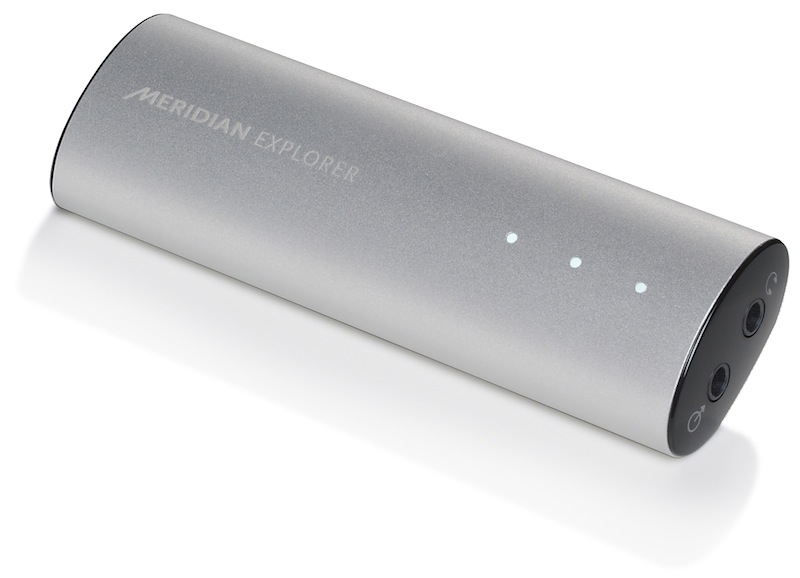
![]()
![]()

![]()
![]()
![]()
![]()
Product Information:
- Product - Meridian Explorer USB DAC
- Price - $299
- Product Page - Link

![]()
![]()
Associated Equipment:
- Source: 15" MacBook Pro w/ Retina Display, C.A.P.S. v3 Carbon Server
- DAC: AudioQuest DragonFly
- Preamp: Spectral Audio DMC-30SS Series 2
- Amplifier: Spectral Audio DMA-260
- Loudspeakers: TAD Labs CR1 Compact Reference
- Headphones: Etymotic ER-4P, Ultimate Ears 11 Pro, Sennheiser HD600
- Remote Control Software: JRemote, Apple Remote
- Remote Control Hardware: iPhone 5, iPad (3rd Generation)
- Playback Software Windows 8: J River Media Center 18
- Playback Software Mac OS X 10.8.2 : Audirvana Plus, Apple iTunes, Sonic Studio Amarra
- Cables: MIT Matrix HD 60 Bi-Wire Loudspeaker Cable, MIT Oracle Matrix 50 Analog Interconnects (RCA), AudioQuest Yosemite (3.5mm to RCA), ALO Audio AC6 Power Cables, Wire World Silver Starlight Mini B to Standard A USB Cable
- Network: Cisco SG200-26 Switch, Baaske MI-1005 Ethernet Isolator, Micro Connectors Augmented Cat6A Ethernet Cable, Apple AirPort Extreme, Cisco RVS4000 Router, Cisco DPC3000 Docsis 3.0 cable modem, Comcast Extreme 105 Mbps Internet Service
![]()


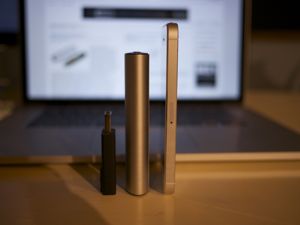
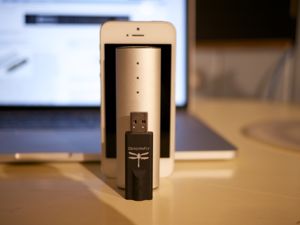
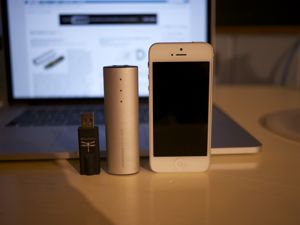
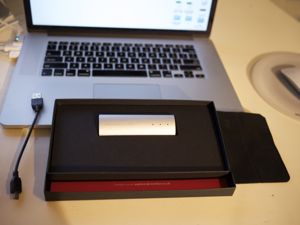








Recommended Comments